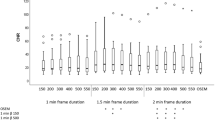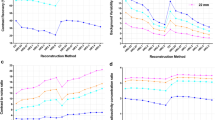Abstract
In this study, we aimed to examine the effect of varying β-values in the block sequential regularized expectation maximization (BSREM) algorithm under differing lesion sizes to determine an optimal penalty factor for clinical application. The National Electrical Manufacturers Association phantom and 15 prostate cancer patients were injected with 68Ga-PSMA and scanned using a GE Discovery IQ PET/CT scanner. Images were reconstructed using ordered subset expectation maximization (OSEM) and BSREM with different β-values. Then, the background variability (BV), contrast recovery, signal-to-noise ratio, and lung residual error were measured from the phantom data, and the signal-to-background ratio (SBR) and contrast from the clinical data. The increment of BV using a β-value of 100 was 120.0%, and the decrement of BV using a β-value of 1000 was 40.5% compared to OSEM. As β decreased from 1000 to 100, the \({SUV}_{max}\) increased by 59.0% for a sphere with a diameter of 10 mm and 26.4% for a sphere with a diameter of 37 mm. Conversely, \({\Delta } {SNR}_{100-1000}\) increased by 140.5% and 29.0% in the smallest and largest spheres, respectively. Furthermore, the Δ\({LE}_{OSEM-100}\) and Δ\({LE}_{OSEM-1000}\) were − 41.1% and − 36.7%, respectively. In the clinical study, OSEM exhibited the lowest SBR and contrast. When the β-value was reduced from 500 to 100, the SBR and contrast increased by 69.7% and 71.8% in small and 35.6% and 33.0%, respectively, in large lesions. Moreover, the optimal β-value decreased as lesion size decreased. In conclusion, a β-value of 400 is optimal for small lesion reconstruction, while β-values of 600 and 500 are optimal for large lesions in phantom and clinical studies, respectively.





Similar content being viewed by others
References
Czernin J, Schelbert H (2004) PET/CT imaging: facts, opinions, hopes, and questions. J Nucl Med 45:1S–3S
Messerli M, Stolzmann P, Egger-Sigg M et al (2018) Impact of a bayesian penalized likelihood reconstruction algorithm on image quality in novel digital PET/CT: clinical implications for the assessment of lung tumors. EJNMMI Phys 5:1–13
Reynés-Llompart G, Gámez‐Cenzano C, Vercher‐Conejero JL, Sabaté‐Llobera A, Calvo‐Malvar N, Martí‐Climent JM (2018) Phantom, clinical, and texture indices evaluation and optimization of a penalized‐likelihood image reconstruction method (Q. Clear) on a BGO PET/CT scanner. Med Phys 45:3214–3222
Lantos J, Mittra ES, Levin CS, Iagaru A (2018) Standard OSEM vs. regularized PET image reconstruction: qualitative and quantitative comparison using phantom data and various clinical radiopharmaceuticals. Am J Nucl Med Mol Imaging 8:110
Ross S (2013) Q.clear (GE healthcare white paper). http://www.enmodedesign.com/MotionFree/QClear_White_Paper_DOC1474189REV_3_2014_06.pdf. Accessed 16 Apr 2015
Teoh EJ, McGowan DR, Macpherson RE, Bradley KM, Gleeson FV (2015) Phantom and clinical evaluation of the bayesian penalized likelihood reconstruction algorithm Q. clear on an LYSO PET/CT system. J Nucl Med 56:1447–1452
Lindström E, Lindsjö L, Sundin A, Sörensen J, Lubberink M (2020) Evaluation of block-sequential regularized expectation maximization reconstruction of 68 Ga-DOTATOC, 18 F-fluoride, and 11 C-acetate whole-body examinations acquired on a digital time-of-flight PET/CT scanner. EJNMMI Phys 7:1–14
Liberini V, Messerli M, Husmann L et al (2021) Improved detection of in-transit metastases of malignant melanoma with BSREM reconstruction in digital [18F] FDG PET/CT. Eur Radiol 31:8011–8020
Caribé PR, Koole M, D’Asseler Y, Van den Broeck B, Vandenberghe S (2019) Noise reduction using a bayesian penalized-likelihood reconstruction algorithm on a time-of-flight PET-CT scanner. EJNMMI Phys 6:1–14
Sasikumar A (2017) Specificity of 68Ga-PSMA PET/CT for prostate cancer-myths and reality. Indian J Nuclear Med: IJNM: Off J Soc Nuclear Med India 32:11
Jonmarker O, Axelsson R, Nilsson T, Gabrielson S (2021) Comparison of regularized reconstruction and ordered subset expectation maximization reconstruction in the diagnostics of prostate cancer using digital time-of-flight 68Ga-PSMA-11 PET/CT imaging. Diagnostics 11:630
Lindström E, Velikyan I, Regula N et al (2019) Regularized reconstruction of digital time-of-flight 68Ga-PSMA-11 PET/CT for the detection of recurrent disease in prostate cancer patients. Theranostics 9:3476
Reynés-Llompart G, Gámez-Cenzano C, Romero-Zayas I, Rodríguez-Bel L, Vercher-Conejero JL, Martí-Climent JM (2017) Performance characteristics of the whole-body discovery IQ PET/CT system. J Nucl Med 58:1155–1161
NEMA (2001) NU 2: Performance measurements of positron emission tomographs. National Electrical Manufacturers Association, Rosslyn, VA, pp 11–12
NEMA I (1998) International standard: radionuclide imaging devices characteristics and test conditions part 1: positron emission tomographs. International Electrotechnical Commission(IEC), Tech Rep, IEC:61675–61671
Monsef A, Ay MR, Sheikhzadeh P, Geramifar P, Rahmim A, Ghafarian P (2022) Harmonization based on quantitative analysis of standardized uptake value variations across PET/CT scanners: a multicenter phantom study. Nucl Med Commun 43:1004–1014
Daube-Witherspoon ME, Karp JS, Casey ME et al (2002) PET performance measurements using the NEMA NU 2-2001 standard. J Nucl Med 43:1398–1409
Lindström E, Sundin A, Trampal C et al (2018) Evaluation of penalized-likelihood estimation reconstruction on a digital time-of-flight PET/CT scanner for 18F-FDG whole-body examinations. J Nucl Med 59:1152–1158
Liberini V, Pizzuto DA, Messerli M et al (2022) BSREM for Brain Metastasis detection with 18F-FDG-PET/CT in lung Cancer Patients. J Digit Imaging 35:581–593
Ter Voert EE, Muehlematter UJ, Delso G et al (2018) Quantitative performance and optimal regularization parameter in block sequential regularized expectation maximization reconstructions in clinical 68Ga-PSMA PET/MR. EJNMMI Res 8:1–15
Lohaus N, Enderlin F, Skawran S et al (2022) Impact of bayesian penalized likelihood reconstruction on quantitative and qualitative aspects for pulmonary nodule detection in digital 2-[18F] FDG-PET/CT. Sci Rep 12:1–10
Trägårdh E, Minarik D, Almquist H et al (2019) Impact of acquisition time and penalizing factor in a block-sequential regularized expectation maximization reconstruction algorithm on a Si-photomultiplier-based PET-CT system for 18F-FDG. EJNMMI Res 9:1–10
Lindstrom E, Lindsjo L, Sundin A, Sorensen J, Lubberink M (2020) Evaluation of block-sequential regularized expectation maximization reconstruction of (68) Ga-DOTATOC, F-18-fluoride, and (11) C-acetate whole-body examinations acquired on a digital time-of-flight PET/CT scanner. EJNMMI Phys. https://doi.org/10.1186/s40658-020-00310-1
Wang Y, Lin L, Quan W, Li J, Li W (2022) Effect of bayesian penalty likelihood algorithm on 18F-FDG PET/CT image of lymphoma. Nucl Med Commun 43:284
Du J, Ariño-Estrada G, Bai X, Cherry SR (2020) Performance comparison of dual-ended readout depth-encoding PET detectors based on BGO and LYSO crystals. Phys Med Biol 65:235030
Miwa K, Yoshii T, Wagatsuma K et al (2023) Impact of γ factor in the penalty function of bayesian penalized likelihood reconstruction (Q. Clear) to achieve high-resolution PET images. EJNMMI Phys 10:4
Afshar-Oromieh A, Avtzi E, Giesel FL et al (2015) The diagnostic value of PET/CT imaging with the 68Ga-labelled PSMA ligand HBED-CC in the diagnosis of recurrent prostate cancer. Eur J Nucl Med Mol Imaging 42:197–209
Funding
This work was supported under Grant No. 52599, Tehran University of Medical Sciences, Tehran, Iran.
Author information
Authors and Affiliations
Corresponding author
Ethics declarations
Conflict of interest
The authors declare that they have no conflict of interest.
Informed consent
No informed consent was required due to the anonymized patient’s data were used.
Research involving human and animal participants
This article does not contain any studies with human participants or animals performed by any of the authors and is only a retrospective study. The anonymized patient’s data were used in this study which approved by Research Ethics Committees of Imam Khomeini Hospital Complex- Tehran University of Medical Sciences (Approval code: IR.TUMS.IKHC.REC.1400.312).
Additional information
Publisher’s Note
Springer Nature remains neutral with regard to jurisdictional claims in published maps and institutional affiliations.
Rights and permissions
Springer Nature or its licensor (e.g. a society or other partner) holds exclusive rights to this article under a publishing agreement with the author(s) or other rightsholder(s); author self-archiving of the accepted manuscript version of this article is solely governed by the terms of such publishing agreement and applicable law.
About this article
Cite this article
Sadeghi, F., Sheikhzadeh, P., Kasraie, N. et al. Phantom and clinical evaluation of Block Sequential Regularized Expectation Maximization (BSREM) reconstruction algorithm in 68Ga-PSMA PET-CT studies. Phys Eng Sci Med 46, 1297–1308 (2023). https://doi.org/10.1007/s13246-023-01299-4
Received:
Accepted:
Published:
Issue Date:
DOI: https://doi.org/10.1007/s13246-023-01299-4




